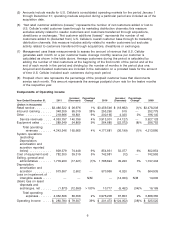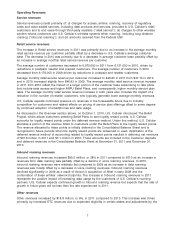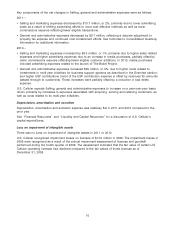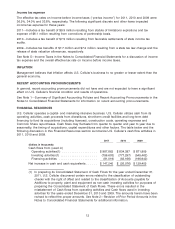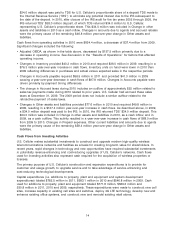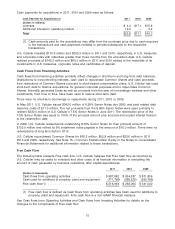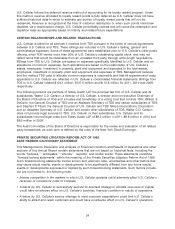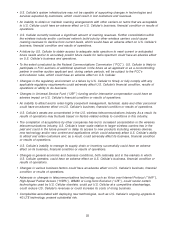US Cellular 2011 Annual Report Download - page 24
Download and view the complete annual report
Please find page 24 of the 2011 US Cellular annual report below. You can navigate through the pages in the report by either clicking on the pages listed below, or by using the keyword search tool below to find specific information within the annual report.LIQUIDITY AND CAPITAL RESOURCES
At December 31, 2011, U.S. Cellular had Cash and cash equivalents, Short-term investments and
Long-term investments totaling $581.3 million, as discussed in more detail below. U.S. Cellular believes
that existing cash and investments balances, expected cash flows from operating activities and funds
available under its revolving credit facility provide substantial liquidity and financial flexibility for U.S.
Cellular to meet its normal financing needs (including working capital, construction and development
expenditures, and share repurchases under its approved program) for the foreseeable future. In addition,
U.S. Cellular may have access to public and private capital markets to help meet its financing needs.
Consumer spending significantly impacts U.S. Cellular’s operations and performance. Factors that
influence levels of consumer spending include: unemployment rates, increases in fuel and other energy
costs, conditions in residential real estate and mortgage markets, labor and health care costs, access to
credit, consumer confidence and other macroeconomic factors. Changes in these and other economic
factors could have a material adverse effect on demand for U.S. Cellular’s products and services and on
U.S. Cellular’s financial condition and results of operations.
U.S. Cellular cannot provide assurances that circumstances that could have a material adverse effect on
its liquidity or capital resources will not occur. Economic conditions, changes in financial markets or
other factors could restrict U.S. Cellular’s liquidity and availability of financing on terms and prices
acceptable to U.S. Cellular, which could require U.S. Cellular to reduce its construction, development,
acquisition or share repurchase programs. Such reductions could have a material adverse effect on U.S.
Cellular’s business, financial condition or results of operations.
Cash and Cash Equivalents
At December 31, 2011, U.S. Cellular had $424.2 million in Cash and cash equivalents, which included
cash and short-term, highly liquid investments with original maturities of three months or less. The
primary objective of U.S. Cellular’s Cash and cash equivalents investment activities is to preserve
principal. At December 31, 2011, the majority of U.S. Cellular’s Cash and cash equivalents was held in
money market funds that invest exclusively in U.S. Treasury securities or in repurchase agreements fully
collateralized by such obligations. U.S. Cellular monitors the financial viability of the money market funds
and direct investments in which it invests and believes that the credit risk associated with these
investments is low.
Short-term and Long-term Investments
At December 31, 2011, U.S. Cellular had $127.0 million in Short-term investments and $30.1 million in
Long-term investments. Short-term and Long-term investments consist of certificates of deposit
(short-term only), U.S. treasuries and corporate notes, all of which are designated as held-to-maturity
investments, and are recorded at amortized cost in the Consolidated Balance Sheet. The corporate notes
are guaranteed by the Federal Deposit Insurance Corporation. For these investments, U.S. Cellular’s
objective is to earn a higher rate of return on funds that are not anticipated to be required to meet
liquidity needs in the near term, while maintaining a low level of investment risk. See Note 4—Fair Value
Measurements in the Notes to Consolidated Financial Statements for additional details on Short-term and
Long-term investments.
Revolving Credit Facility
U.S. Cellular has a revolving credit facility available for general corporate purposes.
In connection with U.S. Cellular’s revolving credit facility, TDS and U.S. Cellular entered into a
subordination agreement dated December 17, 2010 together with the administrative agent for the lenders
under U.S. Cellular’s revolving credit facility. At December 31, 2011, no U.S. Cellular debt was
subordinated pursuant to this subordination agreement.
U.S. Cellular’s interest cost on its revolving credit facility is subject to increase if its current credit rating
from nationally recognized credit rating agencies is lowered, and is subject to decrease if the rating is
raised. The credit facility would not cease to be available nor would the maturity date accelerate solely
16


